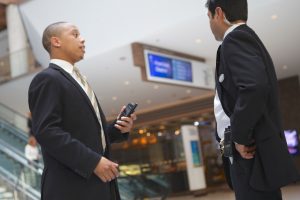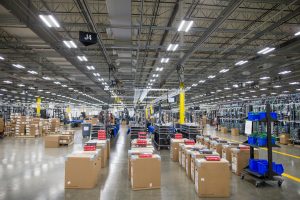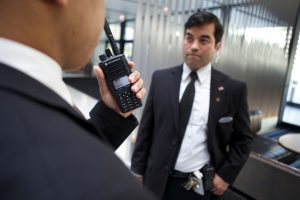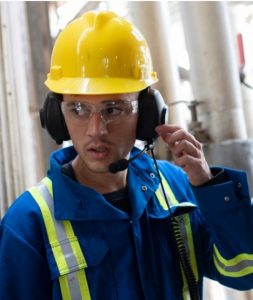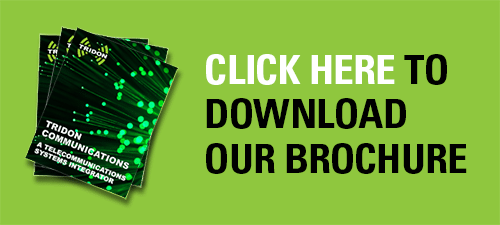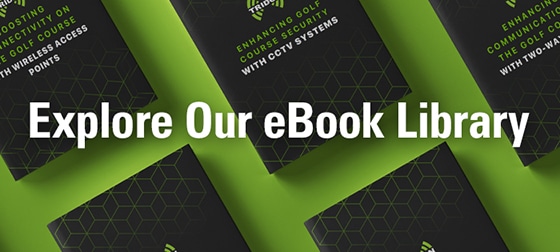Looking for in-building communication solutions?
Contact Us, and we’ll get started.
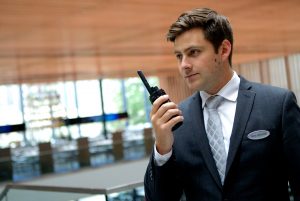
Take a tour of industrial sites, like refineries, and you’ll see two-way radios in use, too. In fact, many industrial environments in the resource sector require intrinsically safe two-way radios by law. They help keep many workers in central and northern Alberta, connected, productive and safe year-round.
Using two-way radios to communicate in these indoor environments presents a set of challenges. Where outdoor communications have to deal with issues like distance and terrain, in-building radio communications have to deal with man-made obstructions like the concrete and steel used in construction.
If you’re thinking of equipping your team and facility with two-way radio gear, here are a few key points that’ll help guide you down the right path.
Consider Going With UHF
UHF stands for Ultra-High Frequency. UHF two-way radios operate in the 406.1-430 MHz and 450-470 MHz frequency bands and, generally speaking, are the go-to radio type for indoor communications. That’s because they have better penetrating power than lower frequency radios like VHF (Very-High Frequency, typically used for outdoor, longer range communications).
Concrete and steel can block and distort radio calls, making them unintelligible. But the penetrating power of a UHF signal means it can move through these obstructions with far less signal loss than a VHF signal could. That means clearer audio for radio users.
UHF signals can degrade over longer distances, however. For example, a manager or security guard on the main floor of an Edmonton office tower might have some trouble reaching a custodian or electrician on the 20th floor. UHF two-way radios are still the preferred choice when communicating in these indoor, multi-story environments, but something called a ‘repeater’ might be necessary.
You Might Need A Signal Booster
Two-way radio users sometimes rely on a type of signal booster called a repeater. It works by receiving the original signal, amplifying it and re-transmitting it (or ‘repeating’ it) to the intended recipient. By doing this, a repeater manages to acquire a signal before it degrades to the point of being unintelligible. Then, it sends it further than it could normally go.
When used indoors, it can also help push a signal through concrete, steel, wood framing, and across multiple floors. That means, with a repeater installed, team members could transmit and receive clear audio signals even when they were several floors apart (as they were in the last example).
If you’re already using two-way radios in your building, but you’re having issues with transmitting and receiving clear signals, you may need a coverage study. An inspection of your equipment or a site survey can help determine the cause of the problem. Contact Us, if you’d like to learn more.
Digital is Superior to Analog
Going with UHF, 800, or 900 MHz instead of VHF is one way to get better two-way radio coverage when working indoors. A repeater (when necessary) is another. Going with digital radios is a third.
When an analog radio transmits a signal, it gets weaker and weaker as it approaches the edges of the coverage area. That means teammates could struggle to understand your message, missing key information and forcing you to repeat yourself. But digital two-way radios don’t face the same problem. They are able to maintain the same level of signal quality throughout the coverage area, meaning you always get the same clear audio.
There’s another reason to go with digital two-way radios, and that’s noise cancellation. Digital radios actively filter out background noise and focus on the voice of the person speaking. That means less background noise drowning out what you have to say, less repetition and clearer communication.
Noise cancellation may not seem like a major need, but it can be. Just think about how noisy some of these environments can get:
- Concert and sports venues like Calgary’s Saddledome or Edmonton’s Rogers Place Arena
- The production floors of manufacturing plants all over Alberta
- Kitchens in major hotels and restaurants
- Heavy machinery operating in pulp mills and refineries
These are work environments you can find all over the province; security, hospitality, oil and gas, manufacturing and resource workers operate in them every day. Noise cancellation, built into the two-way radios these workers are using, means communication can happen more easily in noisy environments. That’s a boost to safety and productivity.
Consider Getting Accessories
Accessories are more than just a ‘nice to have’; they can make using two-way radios easier for your team while providing an additional layer of safety.
Discreet earpieces are great for security staff in hotels and event venues. They allow personnel to communicate without drawing attention and disturbing guests. Speaker mics allow workers to transmit and receive messages without having to reach for the radio on their belt. Heavy duty headsets allow for hands-free communication in noisy work environments, providing hearing protection and the ability to keep both hands on the job. Holsters and clips make carrying the radio easier, and gang chargers allow you to charge multiple units at once, saving space and ensuring radios are fully charged for the next shift.
Get the Right Ingress Protection Rating
You can learn more about ingress protection (IP) ratings by reading our blog on the subject. In a nutshell, an IP rating tells you how well protected your radio is against dust and water (how dustproof and waterproof it is). If your work environment is generally dry and dust-free, like a hotel lobby, this may not be a concern. But, if you’re looking for radios a lifeguard can use while patrolling a swimming pool, or one a millwright can use in a sawmill, you definitely want a high IP rating.
Ultimately, knowing which levels of dustproofing and waterproofing are adequate will depend on knowing your work environment. Water and dust can seriously hinder the performance of a two-way radio, sometimes making it unusable, so getting radios with the right IP ratings is one of the best ways to prevent that from happening.
Getting Started
There are a lot of factors that can impact how well two-way radios work for your team and your facility. This blog touched on a few of the big ones, but every facility is different, and every business has their own needs.
So, if you’re curious about in-building radio solutions, or if you’re stuck with one that doesn’t work like it should, Contact Us. Our Client Support Specialists and RF Technicians will help you build the solution that’s right for your facility and team requirements.
Tridon is a full solution Telecom Systems Integrator with CSA certification and licensed by APEGA. Our Engineering, Service and Tower Divisions collaborate with customers to build engineered solutions including communications systems design, tower inspections and co-location, wireless broadband, fiber optic cabling, site security, and two-way radio communication.

